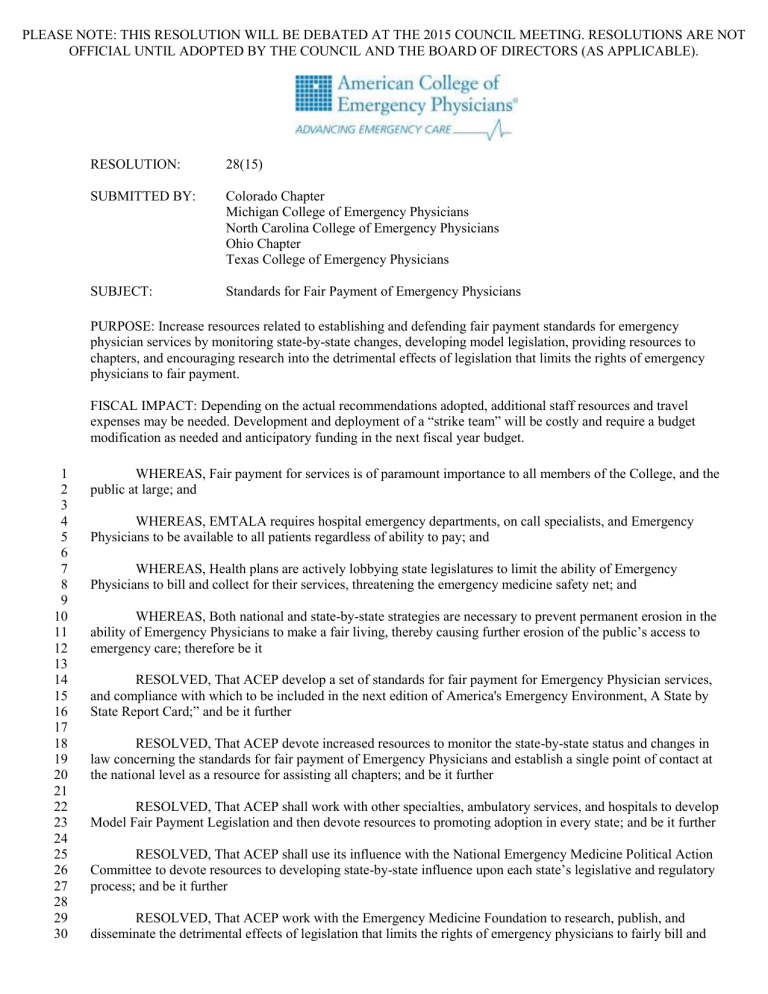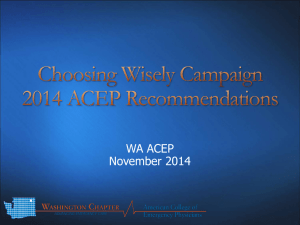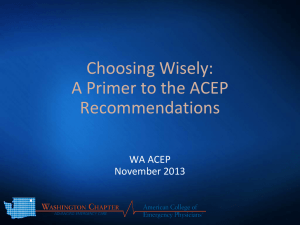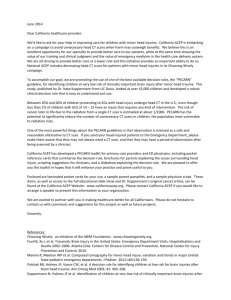Standards for Fair Payment of Emergency Physicians

PLEASE NOTE: THIS RESOLUTION WILL BE DEBATED AT THE 2015 COUNCIL MEETING. RESOLUTIONS ARE NOT
OFFICIAL UNTIL ADOPTED BY THE COUNCIL AND THE BOARD OF DIRECTORS (AS APPLICABLE).
1
22
23
24
25
18
19
20
21
26
27
28
29
30
14
15
16
17
10
11
12
13
6
7
8
9
2
3
4
5
28(15) RESOLUTION:
SUBMITTED BY: Colorado Chapter
Michigan College of Emergency Physicians
North Carolina College of Emergency Physicians
Ohio Chapter
Texas College of Emergency Physicians
SUBJECT: Standards for Fair Payment of Emergency Physicians
PURPOSE: Increase resources related to establishing and defending fair payment standards for emergency physician services by monitoring state-by-state changes, developing model legislation, providing resources to chapters, and encouraging research into the detrimental effects of legislation that limits the rights of emergency physicians to fair payment.
FISCAL IMPACT: Depending on the actual recommendations adopted, additional staff resources and travel expenses may be needed. Development and deployment of a “strike team” will be costly and require a budget modification as needed and anticipatory funding in the next fiscal year budget.
WHEREAS, Fair payment for services is of paramount importance to all members of the College, and the public at large; and
WHEREAS, EMTALA requires hospital emergency departments, on call specialists, and Emergency
Physicians to be available to all patients regardless of ability to pay; and
WHEREAS, Health plans are actively lobbying state legislatures to limit the ability of Emergency
Physicians to bill and collect for their services, threatening the emergency medicine safety net; and
WHEREAS, Both national and state-by-state strategies are necessary to prevent permanent erosion in the ability of Emergency Physicians to make a fair living, thereby causing further erosion of the public’s access to emergency care; therefore be it
RESOLVED, That ACEP develop a set of standards for fair payment for Emergency Physician services, and compliance with which to be included in the next edition of America's Emergency Environment, A State by
State Report Card;” and be it further
RESOLVED, That ACEP devote increased resources to monitor the state-by-state status and changes in law concerning the standards for fair payment of Emergency Physicians and establish a single point of contact at the national level as a resource for assisting all chapters; and be it further
RESOLVED, That ACEP shall work with other specialties, ambulatory services, and hospitals to develop
Model Fair Payment Legislation and then devote resources to promoting adoption in every state; and be it further
RESOLVED, That ACEP shall use its influence with the National Emergency Medicine Political Action
Committee to devote resources to developing state-by-state influence upon each state’s legislative and regulatory process; and be it further
RESOLVED, That ACEP work with the Emergency Medicine Foundation to research, publish, and disseminate the detrimental effects of legislation that limits the rights of emergency physicians to fairly bill and
31
32
33
34
35
36
37
Resolution 28(15) Standards for Fair Payment of Emergency Physicians
Page 2 collect, and to develop effective educational materials explaining the facts concerning emergency physician billing and collection, for use at the national and local level in educating legislators, regulators, policy-makers, and the public; and be it further
RESOLVED, That ACEP and the Emergency Medicine Action Fund develop and support a national
“strike team” that can be deployed by ACEP leadership to help chapters in states where emergency physicians are facing an immediate legislative threat to the fair payment process.
Background
This resolution calls for ACEP to increase resources related to establishing and defending fair payment standards for emergency physician services by monitoring state-by-state changes, developing model legislation, providing resources to chapters, and encouraging research into the detrimental effects of legislation that limits the rights of emergency physicians to fair payment.
ACEP’s policy statement, “ Fair Payment for Emergency Department Services ,” states: “Fair payment for emergency care services, whether government funded or commercially insured, must be sufficient to preserve the nation’s fragile emergency care safety net, and ensure that patients have continued access to all qualified emergency care providers.”
ACEP’s policy statement, “ Balance Billing ,” states: “Systematic underpayment of emergency services without a corresponding system of ensuring fair payment has led to the need to preserve balance billing. This ensures the viability of patient care services where there are no enforced laws or regulations requiring health plans to pay emergency care provider claims at appropriate rates sufficient to maintain the financial viability of our nation’s emergency care safety net.”
The historical difficulty is reaching an agreement on the definition of fair payment. ACEP has advocated for using an unbiased benchmark such as the 80 th percentile of the FAIR Health database to avoid intentional bias from payers or providers and any possibility of price fixing accusations. Any fair payment standard ACEP adopts would have to be agreeable to the membership. The recent CMS’ Office of Consumer Information and Insurance
Oversight (CCIIO) IMPAQ report demonstrated significant variance in pricing across the country.
If such standards could be developed and agreed upon, utilization in any future Report Card on the State of
Emergency Medicine would likely be dependent on the availability of current, relevant and comparable payment data from every state so that it would meet the criteria of Report Card metrics.
The Emergency Medicine Action Fund (EMAF) is a possible source of support, particularly if legal action is an option that a chapter might undertake. EMAF might also be willing to support the mentioned strike team. There is not a direct role for NEMPAC since it only approves contributions to federal candidates.
ACEP’s Recent Advocacy Efforts Related to Balance Billing/Fair Payment Issues:
State-Level Support (previous years):
Significant involvement by ACEP President Michael Gerardi, MD, FACEP, and others in molding language of the National Conference of Insurance Legislators (NCOIL) model bill on balance billing disclosure, specifically excluding emergency care from balance billing bans or disclosure requirements.
Chapter balance billing battles are consistent agenda items on annual ACEP chapter leaders and lobbyists conference calls (2014-NY, 2013-NV, 2012-LA, 2010-NJ and MD, 2009-CA and TX)
Presented out-of-network (OON) payment of emergency care concerns to AMA staff, other national specialty society staff and leadership, and state medical society staff and leadership during a presentation at a national conference in 2009 and 2015 and on AMA state legislative conference calls.
Resolution 28(15) Standards for Fair Payment of Emergency Physicians
Page 3
Provided a 2007 public policy grant of $12,500 to the California Chapter to support PR, legal and other advocacy efforts to combat a balance billing ban. 2009 public policy grant to California to assist in collecting data to help identify the impact of the ban on balance billing.
2010 public policy grant of $12,500 to the New Jersey Chapter to support coalition activities designed to combat insurer efforts to enact legislation that restricts payment of out-of-network emergency providers.
2011 public policy grant of $12,500 to the Illinois Chapter to support potential legal efforts of out-of-network physicians to challenge rule to accept amount offered or be forced to instigate arbitration proceedings.
September 2012, information paper created by the State Legislative/Regulatory Committee and distributed to chapters on lessons learned from California and Nevada chapters regarding legislative efforts related to balance billing.
State laws, NCOIL model, and other resources provided to Nevada Chapter in 2013 facing a balance billing ban. Similar resources provided to Louisiana Chapter in multiple years (5 past chapter presidents testified in
2012).
Signed on to comment letter to National Association of Insurance Commissioners (NAIC) as part of an AMA letter and a separate hospital-based physician caucus letter in November 2014 regarding model legislation on out-of-network payment. Joined hospital-based physician caucus in resubmitting the letter to the NAIC work group in July 2015 while advocating the necessity of providing for maintaining physician rights to bill and fair payment standards in order to maintain the solvency of the health care system safety net.
Provided 2013 assistance to the New York Chapter – including language review, strategy discussions, work with NY Med Society and AMA to encourage more inclusion and acceptance of NYACEP position.
Development, placement and promotion of online chapter resources including model legislation such as:
The Texas right to balance bill for all charges under $1000, at which point patients could require arbitration.
The California legislation passed by the legislature but vetoed by the governor allowing for an interim out of network payment level of 250% of Medicare rates with an independent dispute resolution process available to any party to adjust that interim rate.
The ACEP model legislation based on using a percentile of charges maintained in an independent claims database. (this model was created before the creation of FAIR Health and could now be replaced with a greatest of four type model as is sought at the federal level. See information below regarding new tool kit being developed by the Reimbursement Committee.)
Lessons learned from various chapters in their efforts to fight off balance billing bans.
Talking points related to balance billing from national ACEP and chapters.
Sample testimony on balance billing, including Dr. Gerardi’s testimony to the National Conference of
Insurance Legislators.
Numerous chapter victories over the years at the state level in defeating balance billing bans and/or passing more favorable legislation including WA, NV, LA, FL, NJ, VA, MD, TX, and NC.
State-Level Support (Current Fiscal Year)
Balance billing and related reimbursement issues continues to be included in the legislative tracking service that we provide for the 38 state chapters that request such information.
State Legislative/Regulatory Committee objective: Work with chapters to identify and report on the general impact on emergency medicine reimbursement from significant private payer legislation enacted in recent years in various states (i.e. CA, TX, IL, and NY).
Participation is ongoing in NAIC conference calls dedicated to the adoption of an updated Network Adequacy
Model Law. Balance billing language is being debated as a part of that model. In conjunction with those calls, we have communicated with and coordinated efforts with a group of hospital-based specialty organizations organized informally by the AMA, with the College of American Pathologists, and the Texas Medical
Association. Charles Bregier, MD, FACEP, a member of the ACEP Reimbursement Committee, has participated in NAIC conference calls.
At the request of an ACEP Board member, provided information regarding states with existing balance billing prohibitions. Also provided information regarding a federal court case that ruled against a plaintiff seeking to invalidate state balance billing prohibitions on the basis of federal constitutional due process grounds.
Resolution 28(15) Standards for Fair Payment of Emergency Physicians
Page 4
Based on intelligence received from the Texas Medical Association (TMA) at the AMA’s November meeting in Dallas, ACEP emailed the Texas Chapter office informing them that balance billing legislation similar to the New York legislation would be considered in 2015. Information was also provided to the chapter regarding a request from TMA regarding allegations offered by the health plans that a large number of emergency practice groups terminated contracts when current law took effect.
Out of network payment/balance billing was included on the agenda of the December Chapter Executives and
Lobbyists call in December 2014. Discussion of the issue was led by Louise Prince, MD, FACEP, president of New York ACEP, who discussed that chapter’s experience in negotiating balance billing legislation in NY
State. This resulted in several states contacting the New York Chapter for more information.
The Nevada Chapter reached out to national ACEP regarding whether Texas mediation law would be an appropriate approach for them to take with regard to the perennial balance billing concerns being raised in the legislature there. They were advised that ACEP’s understanding was that both the Texas Chapter and the
Texas Medical Association liked the previously enacted Texas statute and contact information was provided for the Texas Chapter.
Worked with the AMA on opportunity for Dr. Gerardi to speak as part of a pre-conference panel at the
AMA’s State Legislative Advocacy Conference in January. In addition to Dr. Gerardi, the panel included the president of the New York State Medical Society and a physician member of the Texas General Assembly.
Dr. Gerardi presented his take on balance billing and out-of-network payment issues, with a focus on the impact on emergency medicine.
Provided numerous documents to the Florida Chapter regarding balance billing legislation, including information about the New York background and outcome and existing law in Colorado.
Provided New Jersey Chapter lobbyist with talking points and background materials for use in balance billing legislative battle upcoming there.
Objectives for 2015-16 State Legislative/Regulatory Committee include (but not limited to): 1) Research and report on legislation addressing restrictions on balance billing, as well as legislation that sets forth a methodology for determining reimbursement from insurers for out of network services when balance billing is restricted or prohibited; and 2) Work with the Reimbursement Committee on developing resources that would help chapters advocate for appropriate legislative solutions.
Currently working on updating previous balance billing/out of network payment ACEP model to reflect recent developments.
Federal Activity Related to Balance Billing/Fair Payment: Specific Chronology of Events on ACEP Efforts to
Create Transparency in Use of Out-of-Network Greatest of Three Payment Options for Emergency Physicians
Statutory Authority: Section 10101 of the ACA (Sec. 2719A of the Public Health Service Act)
June 26, 2010 – CMS/DOL/IRS release interim final rule on patient protections and OON payment
August 27, 2010 – ACEP submits comments. Rule effective on same date.
February 14, 2012 – Members of the Board of Directors meet with Steve Larsen, Director, CCIIO.
May 7, 2012 – Drs. Jeff Bettinger and Mike Granovsky meet with Alexis Ahlstrom, Larsen’s Sr. Advisor.
She requests us to draft guidance language.
June 8, 2012, Guidance submitted.
June-July 2012 – As requested by CMS, Alston and Bird share draft guidance materials with selected
insurers. Their reaction was negative and they suggested guidelines not be changed.
August 2, 2012 – Drs. Jeff Bettinger and Wes Fields meet with CCIIO Acting Director, Mike Hash (after
Steve Larsen resigns). He promises to review guidance but informs us that nothing will be done until after the
2012 elections.
September 28, 2012 – Follow up call with Mr. Robert Imes and Jim Mayhew CCIIO policy staff (A.
Ahlstrom on maternity leave). They request data/evidence of insurer behavior post-August 2010 reducing
OON emergency physician fees, particularly in states that ban balance billing. (We were unable to provide data.)
March 12, 2013 – Drs. Bettinger and Granovsky meet with new CCIIO Director, Gary Cohen, to resubmit/review the June 2012 guidance document and newer examples of Fair Health UCCs in selected cities/states. Cohen assured us he would provide a definitive answer as to whether CMS will pursue any changes in guidance.
Resolution 28(15) Standards for Fair Payment of Emergency Physicians
Page 5
April 2013 – Mr. Cohen’s Sr. Advisor, Chiquita LaSure asks if we have checked with states on their plans for enforcement. We consider this a major setback as CCIIO has enforcement oversight.
July 9, 2013 – Meet with CCIIO Deputy Director Mike Adelberg and Eugene Freund, MD, Chief Medical
Officer with Drs. Granovsky, Bettinger, and Tom Scully. They ask for more documentation of insurer behavior resulting in large balance bills for enrollees.
February 12, 2014 – Drs. Bettinger and Riner meet with CCIIO Deputy Director Mike Adelberg and Eugene
Freund, MD Chief Officer. We shared many examples of arbitrary changes in insurer payments during 2013, often with the same patients and the same code levels that resulted in huge reductions in payments to EPs and large amounts of enrollee financial liability. Dr. Freund and Mr. Adelberg said they would act on our concerns and get back to us in the next few weeks.
March 7, 2014 – CCIIO Director, Gary Cohen announces his resignation.
April 10, 2014 – CCIIO confirms that they have hired NORC/IMPAQ to analyze and verify claims we
submitted and will respond to us on options CMS may take after reviewing the findings.
September, 2014 – ACEP and EDPMA members are interviewed by the contractor (IMPAQ).
October 14, 2014 – Drs. Bettinger and Granovsky participate in telephone conference call with policy staff from CCIIO, Treasury, and Labor to assess willingness to make changes to the guidance, which was originally issued as a tri-agency product.
December 2014 – IMPAQ submits its report to CCIIO .
January 6, 2015 – CMS informs us that the report will be posted on its web site after Departmental review.
February 11, 2015 – Dr. Gene Freund promises to share an embargoed copy with us, though release timing is uncertain.
March 11, 2015 – Mike Adelberg announces his departure from the CMS’ Center for Consumer Information and Insurance Oversight (CCIIO); Dr. Freund on detail in Africa until May.
March-April 2015 – Numerous calls to CCIIO regarding whereabouts of the IMPAQ report yield no information. ACEP considers a Freedom of Information Request and find that the Obama Administration has a 2-year backlog of requests.
May 2015 – Kevin Counihan (former CT exchange director) appointed new Director of CCIIO
May 29, 2015 – Drs. Bettinger and Granovsky, along with B. Tomar, Mike Park and Earl Pomeroy (Alston and Bird) meet with Mr. Counihan.
Note: Enforcement of the greatest of three falls under state authority to regulate insurance. A process exists for the federal government to step in if a state has “substantially failed to enforce” the provisions, but this process has not been defined or quantified. We will follow CMS efforts in states that have declared that they are not going to enforce ACA market reforms. (AL, MO, OK, TX, WY).
ACEP staff member Barbara Tomar attended each of the meetings/ conference calls with ACEP members.
Reimbursement Department Activities Related to Balance Billing/Fair Payment
The Reimbursement Committee has an objective to work with the State Legislative Committee to develop an updated tool kit for chapters to use in dealing with state reimbursement issues.
In 2009, developed ACEP Policy Statements on Fair Payment and Balance Billing
Obtained a legal opinion on primacy of ACA vs. State law related to balance billing for out of network.
Working with outside counsel on a potential legal action against Data iSight for repricing out of network claims.
Other Reimbursement Department Activity Related to Reimbursement Support for Chapters
Track payer activity by state and currently creating a spreadsheet for members to track activity by payer, by state.
ACEP offers to speak at state reimbursement and coding conferences, and David McKenzie has spoken for chapters in Arizona, Georgia, Idaho, Massachusetts, Michigan, Pennsylvania and Virginia.
The work at RUC and CPT impacts all members, obtaining the highest percentage increase in Medicare payments of all specialties in 2015, and maintaining the GPCI work floor at 1.0 saves rural areas from steep cuts.
Resolution 28(15) Standards for Fair Payment of Emergency Physicians
Page 6
Track Medicare frequency distributions at the state level and post those on the website.
Track Medicaid payments by state and make those available to interested parties.
New educational material is available on ICD-10 implementation and preparing for and surviving payer
audits.
There are 37 sets of reimbursement and coding FAQs updated for 2015 on the ACEP website.
A newly revised paper, “
What Every Graduating Resident Needs to Know About Reimbursement ,” is posted on the ACEP website and made available to residency programs.
The ACEP Reimbursement office receives numerous emails each day from members all over the country on reimbursement issues.
National ACEP Funding for Other State Reimbursement Issues
2008 public policy grant of $12,500 challenging Anthem payment for EMTALA services.
2010 grant of $3,600 to help Massachusetts chapter challenge BCBS credentialing policies for the payment of emergency ultrasound and $12,500 grant to help Michigan chapter challenge BCBS for refusal to pay emergency physicians for plain film interpretation.
2012 public policy grant for $12,500 to assist the Washington chapter in combatting state policy to limit the number of reimbursable non-emergency Medicaid visits to the ED.
2013 public policy grant of $12,500 to help NJ advocate for increased Medicaid rates for emergency physicians.
ACEP has devoted, and continues to focus, a tremendous amount of its resources and activities on reimbursement and fair payment issues.
ACEP Strategic Plan Reference
Pursue strategies for ensuring fair payment and practice sustainability. Tactics include:
Engage ACEP chapters, CMS, and the National Association of State Medicaid Officials in initiating and supporting efforts to minimize the impact of state Medicaid cuts on access to emergency care and to protect the prudent layperson standard.
Collaborate with the AMA, state medical societies, and other medical organizations on payment and practice sustainability issues, including interaction with entities such as FAIR Health, NCOIL, NAIC, and PAI, as appropriate.
Identify payers that do not pay fairly and consider compliance disputes and legal actions through the most strategic available mechanisms.
Monitor balance billing and assignment of benefits issues at the state level and support chapter efforts to pursue legislative and regulatory initiatives that ensure fair payment.
Create and promote resources on fair payment issues for the membership.
-
Advocate to have CMS’ Office of Consumer Information and Insurance Oversight revise regulations on outof-network payments to utilize a transparent and auditable database.
Fiscal Impact
Depending on the actual recommendations adopted, additional staff resources and travel expenses may be needed.
Development and deployment of a “strike team” will be costly and require a budget modification as needed and anticipatory funding in the next fiscal year budget.
Prior Council Action
Resolution 43(05) ACEP Strategic Roles in County, State and American Medical Societies adopted. Directed
ACEP to develop strategies to broaden emergency medicine’s influence in county and state medical societies.
Resolution 38(05) Proper Payment Under Assignment of Benefits adopted. Directed ACEP to advocate for legislation and regulation to ensure that when authorized by the patient, A payer directly reimburses the provider for care.
Resolution 28(15) Standards for Fair Payment of Emergency Physicians
Page 7
Prior Board Action
Resolution 43(05) ACEP Strategic Roles in County, State and American Medical Societies adopted.
Resolution 38(05) Proper Payment Under Assignment of Benefits adopted.
Background Information Prepared by: David McKenzie, CAE
Reimbursement Director
Harry Monroe
Chapter & State Relations Director
Barbara Tomar
Federal Affairs Director
Gordon Wheeler
Associate Executive Director for Public Affairs/Washington Office
Reviewed By: Kevin Klauer, DO, EJD, FACEP, Speaker
James Cusick, MD, FACEP, Vice Speaker
Dean Wilkerson, JD, MBA, CAE, Council Secretary and Executive Director






